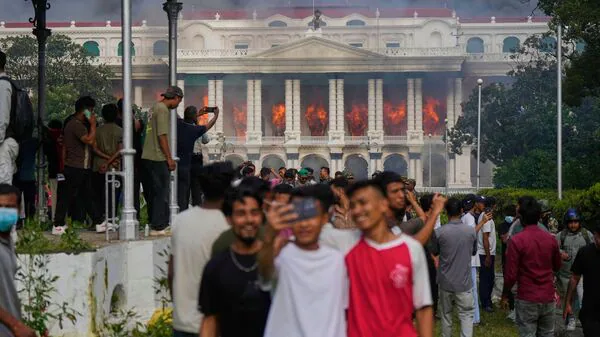(MENAFN- Live Mint) 'Genz' fury engulfed Nepal this week. Mobs burnt Parliament, torched vehicles, vandalised the president's house, stormed into Singha Durbar (the main administrative building for the Nepal government in Kathmandu), allegedly "looted" it and hoisted a flag atop the iconic building. They also violated the curfew orders despite warning and targeted several political leaders.The grim scenes in Nepal bring back memories of Sri Lanka's 2022 economic crisis and Bangladesh's 2024 political turmoi . The protest in all these three country were led by the youth.
Also Read | Nepal Gen Z Protest LIVE: Ex-PM's wife Rabi Laxmi Chitrakar burnt alive Like in Sri Lanka and Bangladesh, the government has been toppled in Nepal as well. Nepal Prime Minister KP Oli resigned from his post on Tuesday to allow "steps towards a political solution".
What's next for Nepal? Who will rule Nepal now? When will the government and normalcy be restored in Nepal? The Sri Lanka and Bangladesh crisis may offer some clues.
Also Read | Why Gen Z protests erupted in Nepal? Protestor answers 'big' question What's next for Nepal?There's no conclusive answer to this as of now. However, these are the following options Nepal is likely to look at to attain normalcy in the country:
1. Caretaker government: Appoint a caretaker government until parliament decide on a new coalition government. According to the Associated Press, Nepal President Ram Chandra Poudel accepted Oli's resignation and appointed him to lead a caretaker government until a new one is in place - though it was unclear what power he would wield or even where he was.
Also Read | UP on high alert in border districts adjoining Nepal amid Gen Z protest 2. Army Deployment: On Wednesday, September 10, armed soldiers guarded the streets of Nepal's capital, ordering people to stay home in an attempt to restore order after mass protests. The Nepali Army announced nationwid e indefinite curfew from Wednesday.
3. Dissolve the government, formation of consensus government: Local media in Nepal called for dissolving the current government, with the prime Minister's post now vacant, and forming a new one.
An aide to President Ramchandra Paudel told Reuters news agency the president had accepted the resignation and begun the "process and discussions for a new leader".
Also Read | 'Some of us don't even have a tomorrow': Miss Nepal Earth plea amid protests 4. Civil unrest continues: The protest by the young and Gen-z is likely to continue amid deep discontent over corruption. Systemic reforms and institutional accountability may help resolve the current turmoil.
The protests revealed a broader resentment in Nepal, where many people have increasingly become angry with the government over a range of issues, mostly to do with corruption and frustration over nepotism in the country's politics.
5. Will King Gyanendra rule Kathmandu again? Many Nepalese locals told AajTak that they favoured the return of the king. A bystander was quoted as saying,“Rajtantra chahiye (We want monarchy). We want the former King to return and take care of the people.”
Also Read | 'We are the fire': Nepali student's fiery speech goes viral amid deadly protests How Sri Lanka and Bangladesh tackled their crisisSri Lanka experienced its worst-ever economic crisis in May 2022. On July 13, ousted President Gotabaya Rajapaksa fled the country and resigned officially on July 14, while in exile.
Then-PM Ranil Wickremesinghe was appointed as the acting president under the Sri Lankan Constitution. On July 20 2022, a special presidential election was held in the House. Wickremesinghe was the majority and was sworn in as the ninth President of Sri Lanka on July 21, 2022.
Also Read | Ranil Wickremesinghe arrested: What is the case against him? Explained Meanwhile, in Bangladesh, the first wave of student protests began on June 5, 2024, over a court's ruling on job quotas . Violence erupted around July 15–16, 2024. A curfew and internet blackout were imposed, and the army was also deployed.
Ousted Prime Minister Sheikh Hasina resigned on August 5. President Mohammed Shahabuddin, in consultation with military chiefs and student protest leaders, appointed Nobel laureate Muhammad Yunus as the head of Bangladesh's interim government (officially termed Chief Adviser). On August 8, 2024, Yunus formally took the oath of office as Chief Adviser.
Also Read | Ranil Wickremesinghe sworn in as Sri Lankan prime minister Sri Lanka vs Bangladesh crisis: Recovery timeline and clues for NepalThe normalcy in Sri Lanka and Bangladesh wasn't an overnight recovery. Short-term recovery was achieved in around one to two months. However, the long-term stability in Sri Lanka was attained by 2024 and in Bangladesh, the work is still on to bring economic and political stability.
The protests in both countries lasted for around a month. Here's a side-by-side comparison and recovery timeline of Sri Lanka and Bangladesh crisis, alongside the current turmoil in Nepal.
If Nepal follows Sri Lanka's path, one can expect 1–2 years before normalcy.
If Nepal mirrors Bangladesh's 2024 transition, stability could return faster (within months) if a broadly accepted caretaker/interim leadership emerges.
In worst case, prolonged deadlock (no consensus, no leadership) could keep Nepal unstable for a longer period.























Comments
No comment